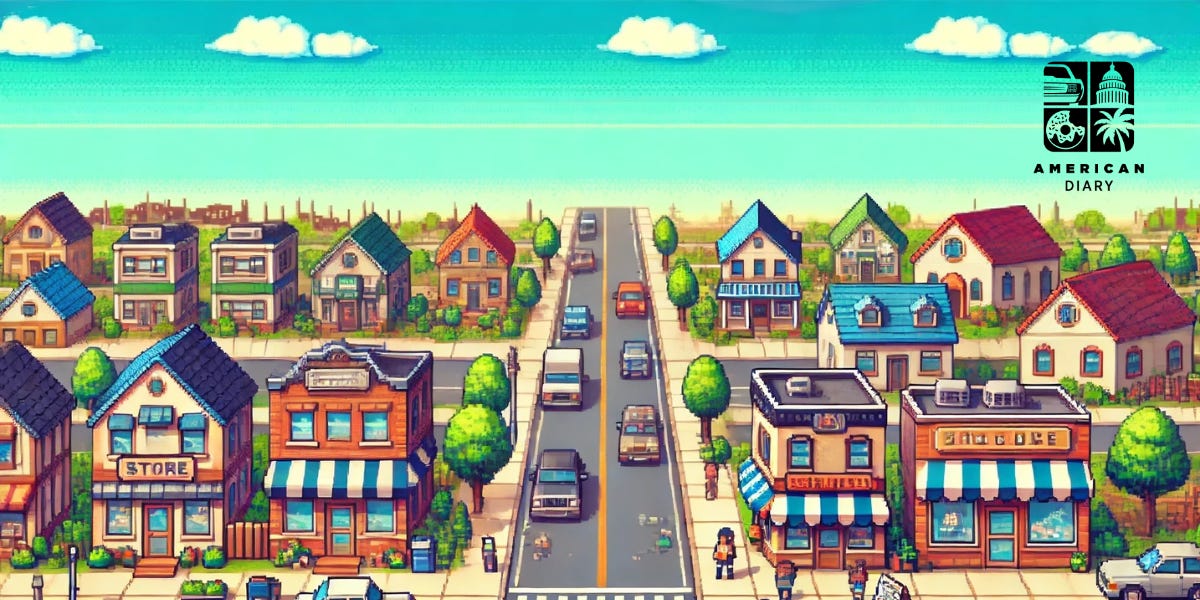|
 |
For this first (i.e., nonintroductory) American Diary column, I want to take you to a place that’s definitely suburban, but also very much informed by the large number of old, pre-automobile small towns, most of them owing their existence to either rail stations or river crossings. What we call “suburbia” or “the suburbs” runs the gamut from the outlying areas around these old towns, all the way to the largely centerless and almost completely car-dependent exurbs at the edges of Sunbelt metros like Houston and Atlanta.
Think of this as an appreciation of a certain kind of suburbia, ordered by the previous generation of development, with at least an echo of the civic and the historic. These are places that have a certain sense of rootedness and permanence—places you can really get to know. It’s a blessing to grow up in a place like that—and believe it or not, video games have given me more perspective to appreciate that.
The Overworld
I recently wrote an essay for my own Substack titled “Unsticking,” which is a word I use to describe making yourself just get up and do things, whether it’s around your house or around your town. “Unsticking” is a way of breaking out of your routine and changing how you do things. Starting with a line from my piece, one commenter wrote:
“To think, oh, he’s the kind of person who does that. It would be interesting to be that kind of person.”
I’ve started to take on this role in my town a bit. I refer to it as living life like a video game protagonist…. It’s amazing what kind of doors open when you just go out and do stuff for folks and take opportunities.
In terms of stuckidness, I’ve strangely found it a lot easier to do chores for other people than it is to do for myself. I’ll happily work on someone else’s yard or clean someone else’s stuff, but I can just never get the motivation to do the same for my own stuff. At least not without some effort and misgivings.
“Living life like a video game protagonist.” I like that. And I thought about it enough to write this whole column bouncing off of it.
In a video game, the setting you come back to throughout the game, which typically connects all the different levels or worlds, is called the “overworld.” Google’s AI Overview pulls together a good definition of it: “a central area that connects other levels or locations, and can also be a safe area where players frequently return.”
A classic element of role-playing games is the “side quest.” While you work to ultimately beat the game, you also work to accomplish tasks for random villagers or people you meet on your adventure. For example, there’s a guy who’d love to see a picture of some monster found only in another part of the map, so you travel there, take a picture, show him, and he’ll give you a healing potion. Or maybe there’s a shop owner in a village who has a feud with someone, and you go talk to that person and mediate a settlement, and you’ll get a discount when you shop at that store.
In a poorly designed video game, these side quests are just a bunch of filler material or “fetch quests.” In an excellent game, you really start to feel like you’re meeting and helping real people, like you’re making friendships, like you belong to the village or town.
All of that is a long way of introducing what my reader’s comment crystallized for me: A classic small town operates in many ways as a real-life overworld for its residents. The other parts of the map—the nearby neighborhoods and outlying areas—share some connection to the town. There’s this physical, geographic center that exerts a force on its little region. The old town is a social and economic lodestone.
In New Jersey, where I grew up, we “came from” whatever small town was closest to us or had the most economic and cultural pull (relatively speaking). The large network of nearby towns functioned as a kind of organizing principle for the suburbia that filled in the gaps later on. They “assigned” you a place of your own that was more lively and interesting than your subdivision or shopping center, and imbued those places with a sense of place and identity. I wasn’t from suburbia; I was “from” Flemington, with all of its particularity and history.
Even if you didn’t live downtown, or within the town limits, much of what you did day to day was mediated through that central physical place. The physical proximity made it easy for one thing to lead to another. In Flemington, we’d go to church and then the Chinese buffet, which was a three-minute drive away. Then we’d walk around the adjacent outlet center or stroll back to Main Street for coffee or ice cream, stop in to see Sal at the pizzeria, and visit the library and greet Mrs. Monahan, the librarian.
You could tread these steps a million times and see many of the same people, but each visit was different. You’d engage in chitchat. You’d get wind of some new development in town—a small-ball political scandal, a new restaurant in the works, a proposal for a vacant property. We’re talking about small-town stuff here, and it was a small world. But it was your world. You did side quests and “leveled up” and explored the map. But you always ended up back in the overworld. It was always there, waiting for you, wherever else life took you. It changed, but in ways that you could experience as a long, slow evolution and not a transformation.
Growing up this way, it was difficult to perceive what was happening. We have a tendency to think that our circumstances are the same thing as our choices. When I noticed even as a kid how spread out some things were, my mother used to say you make your own community. She’d rattle off all the people we knew: Ben at the post office, Mrs. Karen and Mrs. Monahan (at two different library branches), Sal the pizzeria owner and his son Joe, our church friends (we even ran into our pastor at the gym once), and many others. These are the relationships sociologists call “weak ties,” which is not at all to say “unimportant.”
Yes, we made our own community. And you can fail to do that in any type of setting. But if all of those people and places were another 5 or 10 miles away or apart, spread out among even wider and less pleasant roads, in strip plazas instead of along country roads or on Main Streets, would we really have made those rounds so often, run into those people so frequently, felt the leisure to strike up conversations and slowly turn strangers into acquaintances and then friends, instead of anxiously getting into the car for the next visually and physically undistinguished stop? In other words, maybe we thought we were building our own community, not understanding how much the physical context of our lives was contributing to—rather than frustrating—that intention.
The video game analogy works here too. In video games, things that make rote tasks easier (like buying items in shops, or toggling playable characters, or managing the menus) are called “quality of life” elements. It’s obvious when a video game lacks these. For example, there’s usually a shop owner in the game who allows you to select how many of an item you want. If there’s no quantity selection, you have to go through the whole “Thank you for your business! Would you like anything else?” [select item again] “Thank you for your business! Would you like anything else?” loop 10 times.
It’s very easy to identify these discrete things in a video game. It’s a little harder in real life.
Where’s Your Center?
I think this is what I miss the most about New Jersey, living now in Northern Virginia. The landscape here is simply newer, most of it having been built up originally around and after World War II. There isn’t all that much of an older, pre-car, pre-war landscape that Northern Virginia suburbia fits into. The region was largely agricultural, as were most regions in the East, but there were fewer fully formed small towns and cities here. (Arlington County has a few urban areas and streetcar suburbs; Leesburg and Fairfax City are the only really sizable legacy small towns reasonably close to D.C.)
So I don’t really know what or where my “overworld” is here. There isn’t a specific place I belong to by virtue of living in the development I live in, where I can pop into a store and say, “I’m from here. I see you guys just opened up. How’s business so far?”—or any of the other bits of chitchat that simply being in a place makes available to you. And those bits of chitchat will statistically, at some percentage, lead to more.
In the media world, we talk about “funnels”: The top of the funnel might be the social media audience; the bottom of the funnel is the paying subscriber base. At a certain point, you have a conversion ratio, and you can predict your paying subscribers very precisely by measuring the top of your funnel. You know how much revenue you’ll get, and you can increase that revenue simply by widening the top of the funnel.
I don’t like to think about human interaction in this transactional way, but it functions the same, doesn’t it? If 100 interactions with a local business owner lead to something—a job, a friendship, a discount, an invitation to an event or to meet an important person in town, some kind of entry into local business or politics—then you begin to see why land use matters to the formation of community. In a healthy urban setting, be it a town or a city or even an old suburb, the physical context in which you live doesn’t raise the barriers to meeting people, doing things, rustling up opportunities, or having interesting conversations. It doesn’t frustrate opportunities and introduce friction. Ideally, it makes those things easier. It makes them seem and feel physically and psychologically closer.
In the newer suburbs and exurban areas, where chain retail predominates and driving is the default mode of transportation, there isn’t a precise equivalent to “let’s go to Main Street,” with its social and civic element, with its constant potential for the generation of interest and connection. In much of Northern Virginia—and far more so in the exurbs around Richmond south of me, or around Atlanta, or Houston, or Raleigh—most names on the map are collections of residential-only areas (that effectively don’t exist unless you live there or are visiting someone) and commercial-only shopping centers.
Even if the absolute distances aren’t great, the connections are optimized only for driving. I think you could argue that this privatizes not only consumption—which a market economy does, of course—but in a sense also privatizes society. The geographic design eliminates the public, shared context of life and business. In these places, there is no overworld.
It’s sometimes observed that nobody takes wedding photos in housing subdivisions. You could observe, as a sort of corollary, that virtually no video games take place in modern suburbia.
Every adventure game I can think of features old-fashioned villages surrounded by vast expanses of wild land, medieval cities or futuristic ones. Video games, perhaps, aren’t so much escapism as an accidental encapsulation of a lot of what we humans need. Video games have overworlds for design and technical reasons. But they also have overworlds because, in simulating fantastic and unrealistic adventures, they have also captured something fundamentally and deeply human.
You’re currently a free subscriber to Discourse .

